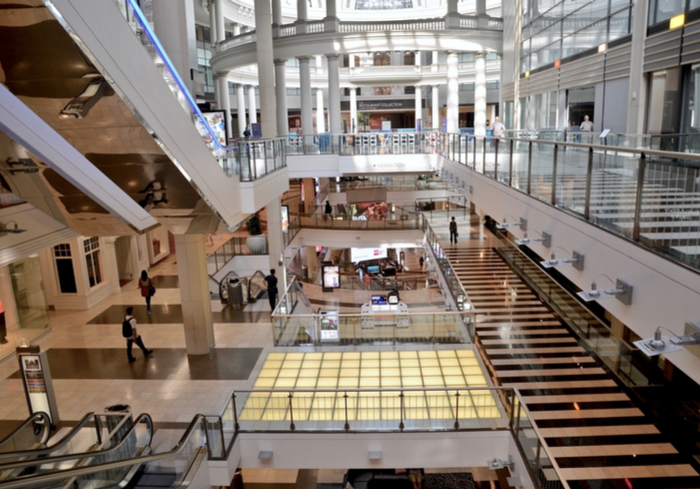
In the future, consumers will come to malls — but they may not come to a large department store with a savings pass in hand. They will be seeking to rewind, relax — and not necessarily search for the latest fashions. As a result, malls and retailers have to rethink how malls are set up and designed.
“The key is to control the shopper’s journey and direct the consumer to the proper place, and malls will transition from anchors to attractions,” A.T. Kearney partner Michael Brown, a co-author of “The Future of Shopping Centers” study, told Chain Store Age. “Department stores will still play a role, but they won’t be the main draw. Whether the draw is office or residential space or an entertainment venue, every property that exists today may be converted to a new purpose.”
And there’s no shortage of space to put to good use. In the U.S., there is 23.5 square feet of retail space for every person. That’s more than five times that in the U.K. or Japan, according to the A.T. Kearney report. With room for new establishments, malls operators are redesigning their spaces to make room for consumer experience spaces like restaurants and gyms.
Store Closures
Large department stores are facing some challenging times. In 2017, JCPenney announced plans to shutter 140 stores, while Macy’s and Sears have also announced plans to close stores inside mall complexes, too.
To make matters worse, multiple large tenants can close in the same mall, which can hit mall owners especially hard. But it’s not just big retailers leaving U.S. malls: Tenants that aren’t classified as department stores are closing in America’s malls, too.
As a result, mall owners – like Simon Properties – are filling the void with expensive upgrades like $500,000 food court renovations. They are building mini-golf courses, rock-climbing gyms and other experience-focused facilities. Even as mall operators make these changes, the balancing act of filling vacant spaces in large shopping malls while maintaining foot traffic is likely to be an ongoing battle for the next few years.
But to fill vacancies, malls can take on tenants such as restaurants. Popular fast-casual eateries — such as The Cheesecake Factory — draw just as many customers to the mall, offer a more unique and personalized experience and are more resistant to consumer habits that seem to be migrating more and more online every day.
“Restaurants are viewed as strong traffic-drivers that draw frequent and regular customer visits, which create opportunities for the neighboring retail offer,” according to a study by CBRE entitled “Now Serving Retail Growth. “For retail landlords, expanding a restaurant offering is a way to counterbalance the declining sales seen in low-growth soft goods categories and build a tenant mix more resistant to eCommerce penetration.”
They key for mall operators is to focus on tangible experiences — like dining out with friends or family — that eCommerce retailers like Amazon can’t deliver in a package. As California-based Piedmont Avenue Consulting’s David Mitroff told the Post, regional malls can compete by featuring “barber shops, gyms, local stores and other things you can’t just buy on Amazon. Or you can go see what they have. You can touch it.”
The Millennials
Millennials have less money to spend on a new suit or dress at stores like Macy’s or Nordstrom as their parents live longer and may exhaust their savings. As a result, millennial children might inherit less wealth and face healthcare expenses for their parents.
But, despite this trend, an uptick in spending on entertainment is projected for the coming years. While just over a third of consumers’ discretionary spending went to experiences in 1985, that figure is projected to rise to nearly half of all discretionary spending by 2030, according to Chain Store Age.
Even if malls capture this spending with new tenants like restaurants, they still face challenges from eCommerce retailers. Millennials, in particular, love to buy clothes online. As a result, millennials reportedly accounted for the largest share of online apparel revenue in both 2015 and 2016 across generations — 35.2 percent in 2015 and 34.6 percent in 2016.
But there still is hope: Generation Z — or those born after 1995 — do not consider malls to be dead. Approximately 60 percent of Generation Z-aged consumers said they continue to shop or visit a mall at least once a month, after all.